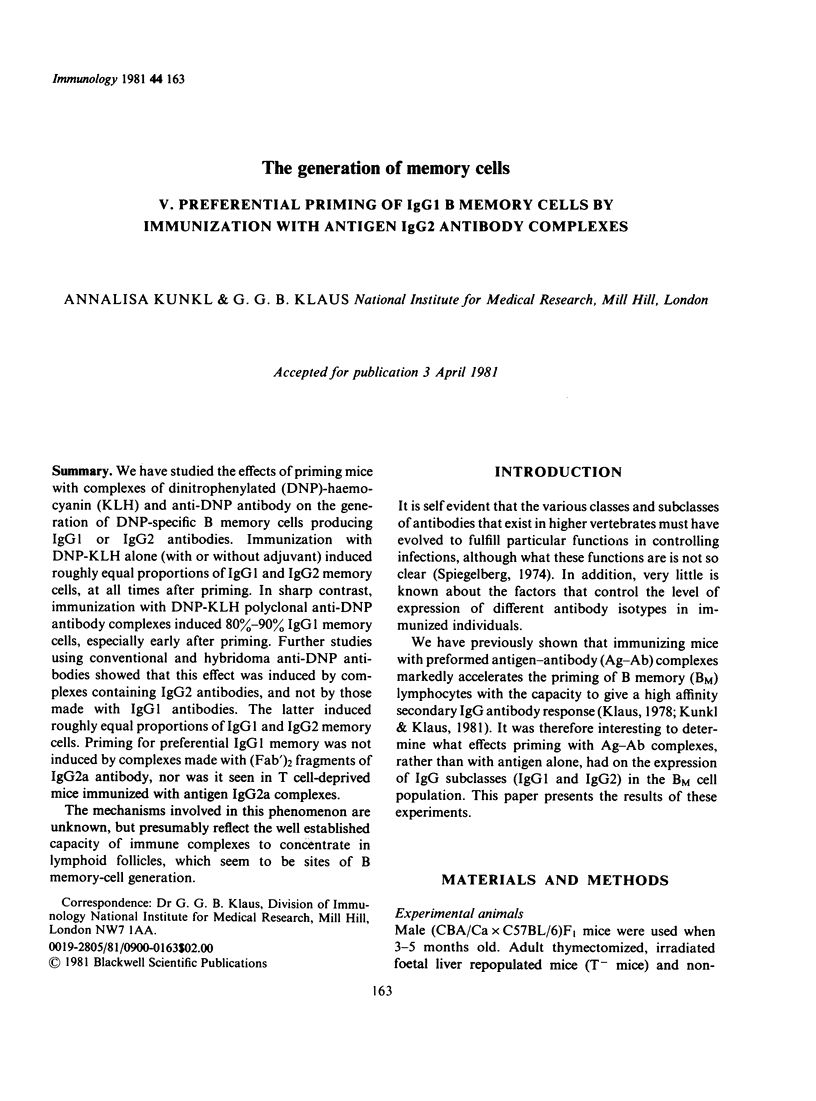Abstract
We have studied the effects of priming mice with complexes of dinitrophenylated (DNP)-haemocyanin (KLH) and anti-DNP antibody on the generation of DNP-specific B memory cells producing IgG1 or IgG2 antibodies. Immunization with DNP-KLH alone (with or without adjuvant) induced roughly equal proportions of IgG1 and IgG2 memory cells, at all times after priming. In sharp contrast, immunization with DNP-KLH polyclonal anti-DNP antibody complexes induced 80%--90% IgG1 memory cells, especially early after priming. Further studies using conventional and hybridoma anti-DNP antibodies showed that this effect was induced by complexes containing IgG2 antibodies, and not by those made with IgG1 antibodies. The latter induced roughly equal proportions of IgG1 and IgG2 memory cells. Priming for preferential IgG1 memory was not induced by complexes made with (Fab')2 fragments of IgG2a antibody, nor was it seen in T cell-deprived mice immunized with antigen IgG2a complexes. The mechanisms involved in this phenomenon are unknown, but presumably reflect the well established capacity of immune complexes to concentrate in lymphoid follicles, which seem to be sites of B memory-cell generation.
Full text
PDF





Selected References
These references are in PubMed. This may not be the complete list of references from this article.
- Elson C. O., Heck J. A., Strober W. T-cell regulation of murine IgA synthesis. J Exp Med. 1979 Mar 1;149(3):632–643. doi: 10.1084/jem.149.3.632. [DOI] [PMC free article] [PubMed] [Google Scholar]
- Herzenberg L. A., Okumura K., Cantor H., Sato V. L., Shen F. W., Boyse E. A., Herzenberg L. A. T-cell regulation of antibody responses: demonstration of allotype-specific helper T cells and their specific removal by suppressor T cells. J Exp Med. 1976 Aug 1;144(2):330–344. doi: 10.1084/jem.144.2.330. [DOI] [PMC free article] [PubMed] [Google Scholar]
- Kishimoto T., Ishizaka K. Regulation of antibody response in vitro. VI. Carrier-specific helper cells for IgG and IgE antibody response. J Immunol. 1973 Sep;111(3):720–732. [PubMed] [Google Scholar]
- Klaus G. G. Generation of memory cells. III. Antibody class requirements for the generation of B-memory cells by antigen--antibody complexes. Immunology. 1979 Jun;37(2):345–351. [PMC free article] [PubMed] [Google Scholar]
- Klaus G. G., Humphrey J. H., Kunkl A., Dongworth D. W. The follicular dendritic cell: its role in antigen presentation in the generation of immunological memory. Immunol Rev. 1980;53:3–28. doi: 10.1111/j.1600-065x.1980.tb01038.x. [DOI] [PubMed] [Google Scholar]
- Klaus G. G., Pepys M. B., Kitajima K., Askonas B. A. Activation of mouse complement by different classes of mouse antibody. Immunology. 1979 Dec;38(4):687–695. [PMC free article] [PubMed] [Google Scholar]
- Kunkl A., Klaus G. G. The generation of memory cells. IV. Immunization with antigen-antibody complexes accelerates the development of B-memory cells, the formation of germinal centres and the maturation of antibody affinity in the secondary response. Immunology. 1981 Jun;43(2):371–378. [PMC free article] [PubMed] [Google Scholar]
- Mason D. W. The requirement for C3 receptors on the precursors of 19S and 7S antibody-forming cells. J Exp Med. 1976 May 1;143(5):1111–1121. doi: 10.1084/jem.143.5.1111. [DOI] [PMC free article] [PubMed] [Google Scholar]
- Seman M., Zilberfarb V. Genetic control of the IgG2a response to sheep erythrocytes in mice: isotype- and antigen-specific T cell-mediated suppression in low responders. J Immunol. 1979 Jun;122(6):2534–2540. [PubMed] [Google Scholar]
- Spiegelberg H. L. Biological activities of immunoglobulins of different classes and subclasses. Adv Immunol. 1974;19(0):259–294. doi: 10.1016/s0065-2776(08)60254-0. [DOI] [PubMed] [Google Scholar]


